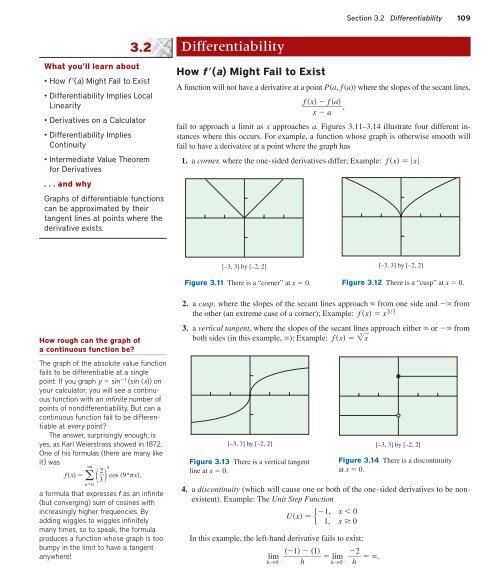5128_Ch03_pp098-184
You also want an ePaper? Increase the reach of your titles
YUMPU automatically turns print PDFs into web optimized ePapers that Google loves.
Section 3.2 Differentiability 109<br />
3.2<br />
What you’ll learn about<br />
• How f (a) Might Fail to Exist<br />
• Differentiability Implies Local<br />
Linearity<br />
• Derivatives on a Calculator<br />
• Differentiability Implies<br />
Continuity<br />
• Intermediate Value Theorem<br />
for Derivatives<br />
. . . and why<br />
Graphs of differentiable functions<br />
can be approximated by their<br />
tangent lines at points where the<br />
derivative exists.<br />
Differentiability<br />
How f (a) Might Fail to Exist<br />
A function will not have a derivative at a point Pa, f a where the slopes of the secant lines,<br />
f x f a<br />
,<br />
x a<br />
fail to approach a limit as x approaches a. Figures 3.11–3.14 illustrate four different instances<br />
where this occurs. For example, a function whose graph is otherwise smooth will<br />
fail to have a derivative at a point where the graph has<br />
1. a corner, where the one-sided derivatives differ; Example: f x x<br />
[–3, 3] by [–2, 2] [–3, 3] by [–2, 2]<br />
Figure 3.11 There is a “corner” at x 0. Figure 3.12 There is a “cusp” at x 0.<br />
How rough can the graph of<br />
a continuous function be?<br />
The graph of the absolute value function<br />
fails to be differentiable at a single<br />
point. If you graph y sin 1 (sin (x)) on<br />
your calculator, you will see a continuous<br />
function with an infinite number of<br />
points of nondifferentiability. But can a<br />
continuous function fail to be differentiable<br />
at every point?<br />
The answer, surprisingly enough, is<br />
yes, as Karl Weierstrass showed in 1872.<br />
One of his formulas (there are many like<br />
it) was<br />
f x <br />
∞<br />
n0<br />
2 3 n cos 9 n x,<br />
a formula that expresses f as an infinite<br />
(but converging) sum of cosines with<br />
increasingly higher frequencies. By<br />
adding wiggles to wiggles infinitely<br />
many times, so to speak, the formula<br />
produces a function whose graph is too<br />
bumpy in the limit to have a tangent<br />
anywhere!<br />
2. a cusp, where the slopes of the secant lines approach from one side and from<br />
the other (an extreme case of a corner); Example: f x x 23<br />
3. a vertical tangent, where the slopes of the secant lines approach either or from<br />
both sides (in this example, ); Example: f x 3 x<br />
[–3, 3] by [–2, 2]<br />
Figure 3.13 There is a vertical tangent<br />
line at x 0.<br />
4. a discontinuity (which will cause one or both of the one-sided derivatives to be nonexistent).<br />
Example: The Unit Step Function<br />
1, x 0<br />
Ux { 1, x 0<br />
In this example, the left-hand derivative fails to exist:<br />
1<br />
lim<br />
h→0 1 lim<br />
h<br />
2<br />
.<br />
h→0 h<br />
[–3, 3] by [–2, 2]<br />
Figure 3.14 There is a discontinuity<br />
at x 0.












